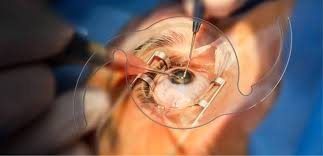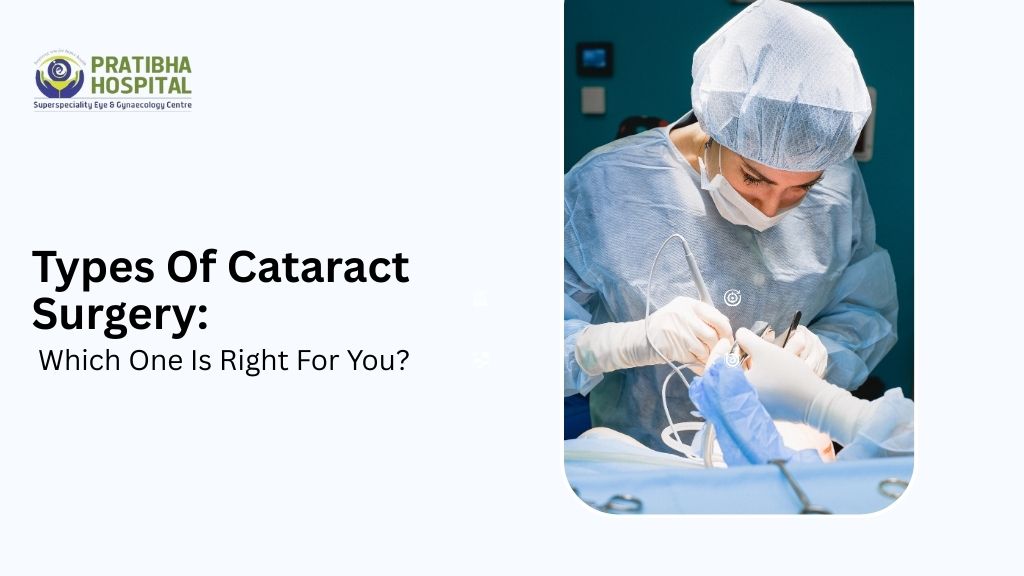Types Of Cataract Surgery: Which One Is Right For You?
Cataracts is so dangerous that it can bring challenges to everyday activities, especially if you are someone who spends time on challenging activities like reading and driving.
The level of seriousness is to that extent that even in some cases, people start to be unable to recognize the face.
Fortunately, cataract surgery offers a reliable solution. But did you know there are multiple methods to perform this procedure?

Understanding the types of cataract surgery available today can help you feel more confident when it’s time to choose. In this blog, we break down the most common techniques, explain your lens options, and guide you on how to make the best decision based on your vision needs.
Understanding Cataracts and the Necessity for Surgery
The first question that is buzzing in the minds of people is What is it? Like we all have heard about motiyabind, this condition is called cataract.
In this, the natural lens of the eyes, which supports clarity in vision, gets cloudy and affects the vision.
It doesn’t improve with medication or glasses. The only effective treatment is to surgically remove the cloudy lens and replace it with an artificial one.
This lens replacement is safe, quick, and has a high success rate. But how it’s done—and what kind of lens you receive—can vary.
Why Knowing The Types Of Cataract Surgery Matters
While the results of cataract surgery are generally positive, the method used can influence the time of recovery and overall experience. Your doctor chooses the cataract surgery type based on:
- The condition of the eye
- The severity of the cataract condition
- The budget of the patient
- Desired visual outcome (with or without glasses)
Having a basic understanding of the options can help you have a better conversation with your ophthalmologist.
The Main Types Of Cataract Surgery
Let’s take a closer look at the commonly performed cataract surgeries in India and around the world:
1. Phacoemulsification (Phaco)
This technique is used all over the world and is considered the standard modern procedure.
Process Overview:
A small incision is made on the surface of the eye. A tiny instrument is used to go inside the area of the eye, which uses ultrasound energy to break the cloudy lens, and with the help of a machine, the small fragments are pulled out very gently.
Why do so many people choose it?
- Minimal invasiveness
- Quick healing time
- No stitches needed in most cases
Best suited for: Most patients with age-related cataracts
2. Femtosecond Laser-Assisted Cataract Surgery (FLACS)
This is a new way that uses a laser to perform the surgical procedure with high accuracy.
How it differs:
Rather than making incisions manually, femtosecond laser technology does it with exactness. The laser also helps in making the cataract soft to get it removed easily.
Key advantages:
- High level of accuracy
- method with no severe cuts with the blade
- Fast improvement in vision is assured
Things to keep in mind:
It’s comparatively costlier and may not be needed for normal cases, but ideal for those seeking the most precise results.
3. Manual Small Incision Cataract Surgery (MSICS)
This method is practiced widely, especially in areas where high-tech equipment may not be available.
How it works:
A somewhat bigger cut is made so the cataract can be taken out completely in one attempt, and after it, the artificial eye lens is implanted for clear vision.
What makes it reliable:
- Doesn’t cost much
- work well for cases of serious conditions
- Trusted technique verified by experts
Keep in mind:
Recovery might be time-consuming compared to laser or phaco procedures.
4. Extracapsular and Intracapsular Cataract Extraction
These are age-old approaches, now typically used in cases that are very specific
Extracapsular Extraction: Involves removing only the cloudy part of the lens, leaving the capsule (the back part) behind.
Intracapsular Extraction: Removes both the lens and its capsule.
What was the reason for using this?
Usually, in situations where the other options for cataract surgeries are not possible due to complicated conditions of the cataract.
Choosing The Right Artificial Lens For Eyes: Intraocular Lens (IOL) Options
The doctor puts a new lens in your eye after the removal of the cataract, called an Intraocular lens. But not every patient does not gets the same type of lens fixed in their eyes.
Let’s have a look at the main types:
Monofocal Lens: Offers clear vision at one distance (either near or far), but there is a chance that you need some supporting lenses to see clearly.
Multifocal Lens: Designed to see from different distances, the clear visuals.
Toric Lens: Corrects astigmatism along with cataracts.
Also, there are options that you can choose based on the budget and the lifestyle.
Laser vs Traditional Cataract Surgery
You might wonder if laser cataract surgery is truly better than traditional methods. Here’s a simple comparison:
| Feature | Traditional (Phaco/MSICS) | Laser (FLACS) |
| Precision | High | Higher |
| Cost | Moderate/Low | High |
| Healing time | Fast | Faster |
| Suitable for all? | Yes | Mostly elective cases |
Laser surgery is the right option for vision needs, but it is always recommended when you need extra accuracy or premium lenses to see clearly.
What To Think About Before Making A Choice
Do consider these essentials for stressless surgery & results:
- Your complete eye health
- Having good financial management
- Surgeon’s experience in the specific technique
A good eye specialist will guide you based on what’s safe and beneficial for your case.
After Surgery: Recovery And Care
Recovery generally goes well, especially with advanced methods like phaco and laser. Most patients feel the difference within a few days. However, taking precautions cannot be overlooked:
- A big no to touch or rub your eyes
- Use the eye drops as prescribed by experts
- Avoid lifting heavy objects and dusty environments
- Attend follow-up appointments
Also read: Post-operative Care After Cataract Surgery: A Complete Guide
Conclusion
When it comes to your eyes, making informed choices is crucial. Each of the types of cataract surgery discussed above has its place, benefits, and suitability. There is no “one best” surgery; it depends on what’s best for you.
If you or a loved one is facing cataracts, don’t hesitate to ask questions. Discuss your expectations and concerns with your doctor, and together, you can select the option that leads to the clearest outcome.







